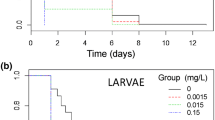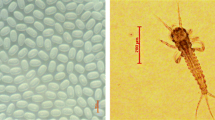The life cycle of the damselfly Calopteryx atrata was investigated in relation to pesticide contamination occurring in its aquatic habitat. Calopteryx atrata emerged from the River Onogawa around May and stayed as immature adults in forests away from the stream. From late June to mid-August, mature adults were engaged in reproduction at the stream. On the other hand, pesticide contamination occurred from April to August with its peak in May and June, following transplantation of young rice plants. Mature nymphs of C. atrata experienced pesticide contamination, but may have tolerated it. Hatched nymphs had high susceptibility to two of the commonly used insecticides, fenitrothion (mortality occurred at >4.0 μg l-1 in 24 h and at >2.0 μg l-1 in 48 h) and fenthion (>2.0 μg l-1 in 24 h and >1.0 μg l-1 in 48 h). Hatching was estimated to occur mainly in August, when pesticide contamination was not as high as the susceptibility level. However, the level of pesticide contamination in August is variable due to its origin from aerial spraying, so hatched nymphs may experience a hazardous amount of pesticides depending on the year or place. The population of C. atrata does not escape the risk of pesticide contamination completely and may be affected by it.
Similar content being viewed by others
References
Clubb R.W., Gaufin A.R. and Lords J.L. (1975) Acute cadmium toxicity studies upon nine species of aquatic insects. Environ. Res. 9, 332–41.
Gauss J.D., Woods P.E., Winner R.W. and Skillings J.H. (1985) Acute toxicity of copper to three life stages of Chironomus tentans as affected by water hardness-alkalinity. Environ. Pollut. 37, 149–57.
Hatakeyama S. (1988) Chronic effects of Cu on reproduction of Polypedilum nubifer (Chironomidae) through water and food. Ecotoxicol. Environ. Safety 16, 1–10.
Hatakeyama S., Shiraishi H. and Kobayashi N. (1990) Effects of aerial spraying of insecticides on nontarget macrobenthos in a mountain stream. Ecotoxicol. Environ. Safety 19, 254–70.
Hatakeyama S. and Shiraishi H. (1991) Chronic effects of waterborne or dietary exposure to a herbicide, chlornitrofen (2,4,6-trichlorophenyl-49-nitrophenyl ether), on reproduction of Polypedilum nubifer (Chironomidae). Water Res. 25, 945–51.
Hatakeyama S., Shiraishi H. and Sugaya Y. (1991a) Monitoring of the overall toxicity of river water to aquatic organisms using a freshwater shrimp, Paratya compressa improvisa. Chemosphere 22, 229–35.
Hatakeyama S., Shiraishi H. and Hamada A. (1991b) Seasonal variation of pesticide toxicity bioassayed using a freshwater shrimp (Paratya compressa improvisa) in water collected from rivers of the Lake Kasumigaura water system. Water Pollut. Res. 14, 460–8 (in Japanese with English abstract).
Hatakeyama S., Fukushima S., Kasai F. and Shiraishi H. (1992) Assessment of the overall herbicide effects on algal production in the river. Jpn. J. Limnol. 53, 327–40.
Hatakeyama S., Fukushima S., Kasai F. and Shiraishi H. (1994) Assessment of herbicide effects on algal production in the Kokai River (Japan) using a model stream and Selenastrum bioassay. Ecotoxicology 3, 143–56.
Ishida S., Ishida K., Kojima K. and Sugimura M. (1988) Illustrated Guide for Identification of t Japanese Odonata. Tokyo: Tokai University Press (in Japanese).
Iwakuma T., Takamura K. and Nohara S. (1988) Dynamics of benthic communities in tributaries of the River Koise in relation to residual pesticides. Res. Rep. Natl Inst. Envirron. Stud. Jpn. 114, 85–109 (in Japanese with English abstract).
Iwakuma T., Shiraishi H., Nohara S. and Takamura K. (1993) Runoff properties and changes in concentrations of agricultural pesticides in a river system during a rice cultivation period. Chemosphere 27, 677–91.
McKim J.M. (1977) Evaluation of tests with early life stages of fish for predicting long-term toxicity. J. Fish. Res. Board Can. 34, 1148–54.
Maki A.W., Geissel L. and Johnson E. (1975) Comparative toxicity of larval lampricide (TFM: 3-trifluoromethyl-4-nitrophenol) to selected benthic macroinvertebrates. J. Fish. Res. Board Can. 32, 1455–9.
Ono H. and Nakanishi J. (1987) Herbicide, CNP contamination in the Lake Kasumigaura basin. Water Res. 21, 669–75.
Powlesland C. and George J. (1986) Acute and chronic toxicity of nickel to larvae of Chironomus riparis (Meigen). Environ. Pollut. 42, 47–64.
Takamura K., Hatakeyama S. and Shiraishi H. (1991a) Odonate larvae as an indicator of pesticide contamination. Appl. Ent. Zool. 26, 321–6.
Takamura K., Nohara S., Kariya T., Okazaki M. and Ito K. (1991b) Effects of pesticide contamination from rice fields on stream benthic arthropods. Jpn. J. Limnol. 52, 95–103.
Yamato Y. and Suzuki M. (1980) Occurrence of herbicide oxadiazon in surface waters and tap water. Water Res. 14, 1435–8.
Author information
Authors and Affiliations
Rights and permissions
About this article
Cite this article
Takamura, K. Life cycle of the damselfly Calopteryx atrata in relation to pesticide contamination. Ecotoxicology 5, 1–8 (1996). https://doi.org/10.1007/BF00116319
Received:
Accepted:
Issue Date:
DOI: https://doi.org/10.1007/BF00116319




